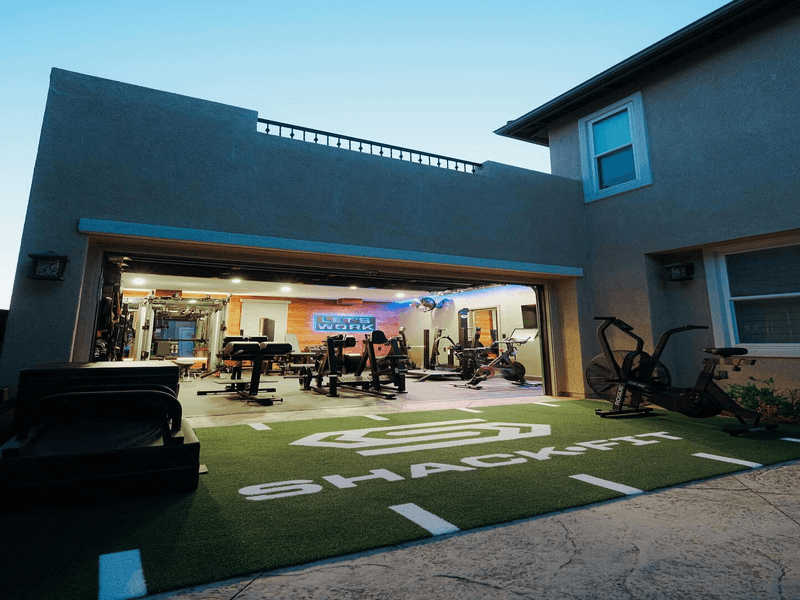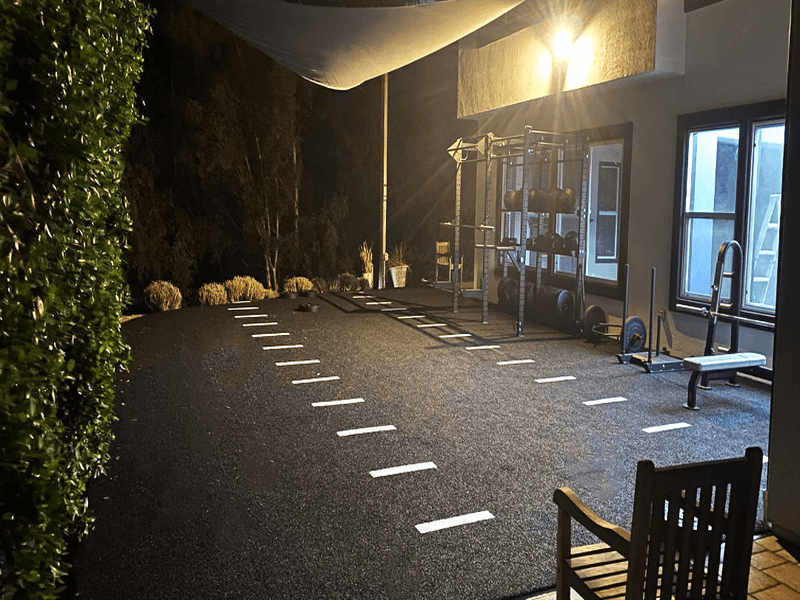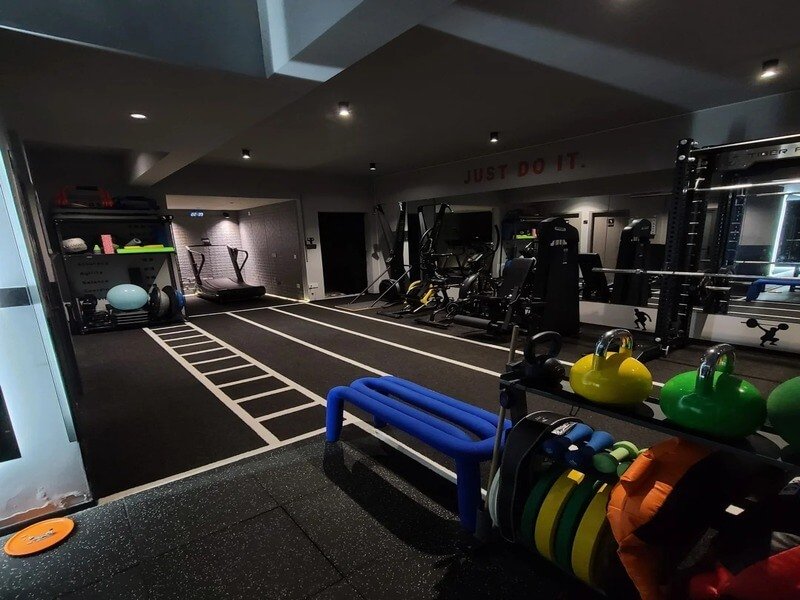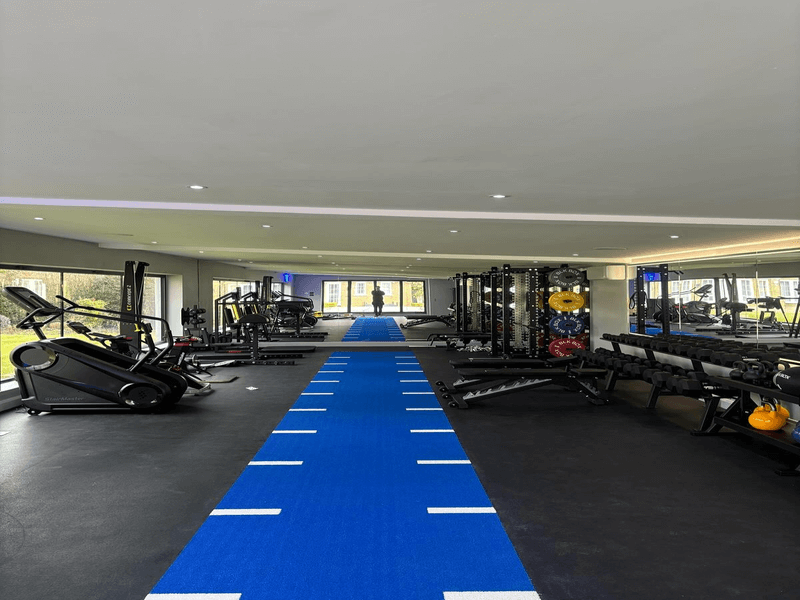Padded turf combines artificial grass fibers with a 5mm PU foam backing that provides superior impact absorption and joint protection. This cushioned surface reduces injury risk during high-intensity workouts while eliminating the need for rubber infill, making it ideal for indoor home gym applications.
Selecting the right padded turf for your home gym can transform your workout experience from ordinary to exceptional. The key lies in understanding how the integrated foam padding works with different fiber types to create a surface that protects your joints while withstanding intense training sessions. I learned this firsthand when I installed my first padded turf system – the difference in comfort during burpees and sled pushes was immediately noticeable. The 5mm PU foam layer acts as a shock absorber, distributing impact forces across a wider area and reducing stress on knees, ankles, and hips. This technology eliminates the maintenance headaches of traditional infilled systems while providing consistent performance year-round.

Understanding these fundamentals will guide you through the selection process, ensuring your investment delivers both performance and longevity for your home fitness space.
What Training Activities Will Drive Your Turf Selection?
Your primary workout types determine the specific turf characteristics you need. High-intensity interval training requires different cushioning than yoga, while sled training demands shorter pile heights for optimal equipment performance and safety.
I always start by mapping out my clients’ training routines because this single factor influences every other decision. HIIT and CrossFit athletes need maximum impact absorption for explosive movements like box jumps and burpees. The padded backing becomes crucial here, as it prevents joint fatigue during repeated high-impact exercises. Sled training and battle rope workouts require shorter pile heights – typically 15-25mm – to prevent equipment from getting caught in longer fibers while still benefiting from the underlying cushioning.
Matching Turf Specs to Training Types
| Training Type | Pile Height | Padding Priority | Key Features |
|---|---|---|---|
| HIIT/CrossFit | 20-30mm | Essential | Maximum impact absorption |
| Sled/Battle Ropes | 15-25mm | Moderate | Low profile, equipment-friendly |
| Yoga/Stretching | 25-35mm | Hoog | Soft surface, joint comfort |
| Weightlifting | 20-30mm | Essential | Stable platform, shock absorption |
For families with children, consider higher pile heights that provide extra cushioning for play activities. I recommend creating zones within your gym space – shorter turf for equipment areas and taller, softer sections for floor exercises and stretching.

This activity-based approach ensures every square foot of your gym serves a specific purpose while maintaining the comfort and safety benefits of padded construction.
Which Fiber Materials Offer the Best Performance Balance?
Polyethylene fibers provide the optimal combination of softness and durability for padded turf systems. They offer superior comfort for ground-based exercises while maintaining resilience under heavy equipment use, making them ideal for multi-purpose home gyms.
After testing dozens of fiber combinations in real gym environments, I consistently recommend polyethylene for padded turf applications. The material’s inherent flexibility complements the foam backing perfectly, creating a surface that feels natural underfoot while resisting matting and wear. Nylon fibers, while extremely durable, can feel harsh against skin during floor exercises despite the padding underneath.
Fiber Performance Characteristics
The face weight measurement tells you how much fiber material covers each square yard. For home gyms, I recommend minimum face weights of 40-50 ounces for polyethylene systems. This density ensures the turf maintains its appearance and performance even with daily use. The stitch rate – measured in stitches per inch – should be 8-10 for optimal durability without creating an overly stiff surface.
Polypropylene offers budget-friendly options but lacks the resilience needed for intensive training. These fibers tend to flatten quickly under equipment weight, reducing both appearance and performance over time. The investment in quality polyethylene pays dividends in longevity and user satisfaction.

Your fiber choice directly impacts how the padding performs, so prioritizing quality materials ensures maximum return on your investment.
How Does Padding Construction Affect Performance?
The 5mm PU foam padding bonded to the turf backing provides consistent shock absorption that significantly reduces joint stress during workouts. This closed-cell foam construction maintains its cushioning properties over time while resisting moisture and bacterial growth.
I have seen the dramatic difference proper padding makes in injury prevention and workout comfort. The closed-cell PU foam used in quality padded turf systems compresses under impact then immediately returns to its original thickness. This consistent rebound effect reduces fatigue during extended training sessions and provides reliable protection for high-impact movements.
Understanding Padding Technology
The foam is permanently bonded to the turf backing using industrial adhesives that withstand temperature changes and repeated stress. This construction eliminates the shifting and separation issues common with separate pad underlayments. The 5mm thickness provides optimal cushioning without creating an unstable surface that could affect balance during lifting movements.
Closed-cell foam resists moisture absorption, preventing the bacterial growth and odors that plague open-cell alternatives. This characteristic proves essential in home gym environments where ventilation may be limited. The material also provides some insulation value, making floor exercises more comfortable on concrete substrates.

This integrated approach delivers superior performance compared to systems requiring separate padding installation, while simplifying the entire installation process.
Should You Choose Rolls or Interlocking Tiles?
Turf rolls provide seamless installation with fewer joints and professional appearance, while interlocking tiles offer easier DIY installation and future flexibility. For most home gyms, 12-foot wide rolls deliver the best combination of performance and aesthetics.
My experience with both formats shows that rolls create the most professional-looking installations with minimal seam visibility. The continuous surface prevents equipment from catching on edges and provides consistent padding across the entire area. However, rolls require careful measuring and cutting, making installation more challenging for DIY enthusiasts.
Installation Considerations by Format
Interlocking tiles excel in irregularly shaped spaces or when future reconfiguration seems likely. Each tile typically measures 2×2 feet with engineered edges that lock together securely. The modular design allows easy replacement of damaged sections without disturbing the surrounding area. Installation requires no special tools or adhesives, making it accessible for most homeowners.
| Format | Pros | Cons | Best For |
|---|---|---|---|
| Rolls | Seamless appearance, professional look | Complex installation, transport challenges | Permanent installations, large spaces |
| Tiles | Easy DIY install, modular replacement | Visible seams, potential shifting | Temporary setups, irregular spaces |
The choice often comes down to your installation comfort level and long-term plans for the space. Rolls provide superior aesthetics but require more planning and precision during installation.

Consider your space dimensions, installation skills, and future flexibility needs when making this crucial decision.
What Installation Method Works Best for Your Space?
Most padded turf installations succeed with the gravity method – simply rolling out the material without adhesives. The integrated padding provides enough weight and grip to prevent shifting during normal use while allowing easy removal if needed.
I recommend the gravity installation method for most home gym applications because it simplifies both installation and future changes. The combined weight of the turf and padding creates sufficient friction against the subfloor to prevent movement during workouts. This approach works particularly well on concrete, existing flooring, or properly prepared subflooring.
Step-by-Step Installation Process
Surface preparation begins with thorough cleaning and inspection for any irregularities that could create pressure points. Small debris or surface imperfections can create wear patterns over time, so attention to detail pays dividends. Measure your space carefully, allowing for walls and fixed equipment placements.
When cutting turf rolls, use a sharp utility knife and cut from the backing side for clean edges. Leave slight expansion gaps along walls – about 1/4 inch – to accommodate any temperature-related movement. For tile installations, start from the center of the room and work outward to ensure even spacing.
Professional installation becomes worthwhile for spaces over 500 square feet or when dealing with complex shapes and permanent fixtures. The cost difference often justifies itself through time savings and guaranteed results.

Proper installation ensures your padded turf performs optimally throughout its lifespan while maintaining its attractive appearance.
How Do You Maintain Padded Turf for Maximum Lifespan?
Regular vacuuming and occasional damp mopping with mild soap maintain padded turf appearance and hygiene. The foam backing requires no special maintenance but benefits from periodic fiber brushing to maintain upright positioning and professional appearance.
Maintenance routines for padded turf are refreshingly simple compared to traditional gym flooring. Weekly vacuuming removes dust, hair, and small debris that could work into the fiber base over time. I use a standard household vacuum with brush attachment, working in multiple directions to lift embedded particles effectively.
Weekly and Monthly Maintenance Tasks
For spot cleaning, mild dish soap mixed with warm water handles most stains effectively. Avoid harsh chemicals or bleach-based products that could damage the polyethylene fibers or foam backing. Rinse thoroughly with clean water and allow complete air drying before resuming workouts.
Monthly brushing with a stiff-bristled push broom helps maintain fiber orientation and prevents matting in high-traffic areas. Work against the grain first, then with the grain to achieve optimal fiber positioning. This simple step dramatically extends the turf’s attractive appearance.
| Maintenance Task | Frequentie | Tools Needed | Time Required |
|---|---|---|---|
| Vacuuming | Wekelijks | Standard vacuum | 10-15 minutes |
| Spot cleaning | Naar behoefte | Mild soap, water | 5-10 minutes |
| Fiber brushing | Maandelijks | Stiff broom | 15-20 minutes |
| Dieptereiniging | Driemaandelijks | Carpet cleaner | 30-60 minutes |
The foam padding requires no special attention but benefits from protection against sharp objects that could puncture or tear the backing material.

Consistent maintenance preserves both the appearance and performance characteristics that make padded turf such an excellent home gym investment.
Conclusie
Choosing the right padded turf transforms your home gym into a professional-grade training environment that protects your joints while delivering exceptional durability and easy maintenance.
Ready to Upgrade Your Home Gym?
Contact us today for a free consultation and sample kit. Our turf specialists will help you select the perfect padded turf solution for your specific training needs and space requirements. Get your personalized quote and see the quality difference for yourself!
